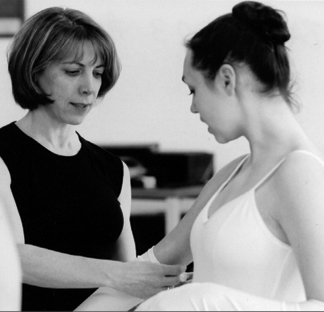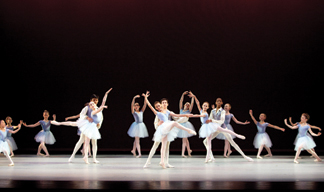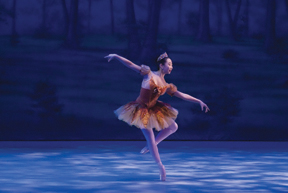A Non Dancing Ballet Career at Ballet Academy East
By Francine L. Trevens
ART TIMES Online August 2010
 Photo of Julia Dubno taken during rehearsal of the 2003 BAE Student Company Spring Performance. The alumni dancer in the photo is Daria Foner. Photo credit: Rosalie O’Connor Photo of Julia Dubno taken during rehearsal of the 2003 BAE Student Company Spring Performance. The alumni dancer in the photo is Daria Foner. Photo credit: Rosalie O’Connor |
What if you love ballet, want to be part of that world, but acknowledge you cannot be a professional dancer?
One answer is to teach. A better reply, for an organized, dedicated person, is to run a ballet school. That was the choice Julia Dubno made.
When is a dance recital not a recital?
Ms. Dubno makes the answer to that question — when it is Ballet Academy East‘s Spring Performance.
Perhaps the professional brochures, the elegant announcements, or the reputation of BAE induced a general dance loving community to attend. The press release inspired me to go to John Jay College to see BAE, though I came as a skeptic, assuming the performances probably would not be equal to the promotional materials. I left an aficionado. This evening of ballet was superior to the work of many professional companies I have viewed. There were weaknesses, to be sure. Most notable, in male dancer’s partnering techniques, for example. But the overall program, including the “Cinderella’s Ball” final segment were most enjoyable.
 La Bayadère Pas d’Action, staged by Cheryl Yeager and Jennifer Davidson; Dancer is Hannah Marshall. Photo credit: Kyle Froman La Bayadère Pas d’Action, staged by Cheryl Yeager and Jennifer Davidson; Dancer is Hannah Marshall. Photo credit: Kyle Froman |
I am often approached about where to send someone to study dance. I do not make recommendations. I was impressed when Julia Dubno, who founded BAE in 1979, when asked that question, replied, “There are many great schools. Some students need to try a few in order to find the right one for them. A school perfect for one might not be the right fit for someone else.”
BAE has expanded since its inception and now has 5 studios. While Ms Dubno credits her various instructors for the school’s success, I credit her.
So who is Julia Dubno and how did she get that way? In her own words:
“At age 8 I told my mother I wanted to try ballet. My friend was studying at a school in Carnegie Hall called the Fine Arts Workshop. I went to a class."
“We faced the barre and did grand plié a la seconde. As soon as I began to plié I fell in love. At age twelve I attended the Fokine Ballet Summer Camp in Lenox, Massachusetts, and decided to study exclusively at Fokine Ballet School. It was my “ballet home” until I was seventeen. The main teacher I studied with was Francis Patrelle. Our relationship has spanned almost 40 years, and he was the first teacher hired by me and remains at BAE to this day."
“At seventeen I attended The Juilliard School as a dance major. I had very little performing experience prior to Juilliard and was coming to realize that I preferred the backstage and studio experience to the stage."
“I received a call from Miss Fokine, who was having health problems and needed someone to help run her school. Although it was hard to change course after dreaming of dancing professionally for so many years, I knew it was the right decision."
 Little Mozart, choreographed by Jenna Lavin dancers are levels three and four (levels go up to 9) Photo credit: Rosalie O’Connor Little Mozart, choreographed by Jenna Lavin dancers are levels three and four (levels go up to 9) Photo credit: Rosalie O’Connor |
“I worked with Miss Fokine for a year and loved it. She taught me everything about running a ballet school. I worked at the front desk, taught pre-ballet classes, handled the books and did everything else that needed to be done. We were close and our relationship over this time became even closer. When she decided to close the Fokine Ballet School after over 40 years, due to health issues, she offered to help me start my own school. This was the beginning of Ballet Academy East.” (Incidentally, I asked: there is no Ballet Academy West.)
The long lasting friendships and business associations in Ms. Dubno’s professional life testify to her dedication to people and ballet.
As with any dance training institution, there are classes just for those who dance as a form of recreation or body training. “The pre-ballet and adult ‘open classes’ have always been strong programs and continue to grow and develop thanks to BAE’s dedicated faculty and administrators,” Ms Dubno noted.
The pre-professional courses are designed for those who wish a career in ballet. These students have as many as 5 classes a week required for the upper pre-professionals. I wondered how youngsters still in school managed it all.
“Most technique classes are 1 ½ hours long. Some pointe, variations, men’s classes are one hour long and generally follow a technique class. The attendance requirements for the upper level students are quite demanding. These dancers are extremely dedicated and focused. I have found that this follows through in all areas of their life. Most of them are excellent students academically as well. Graduates of BAE who have not gone on to dance professionally have gotten into the top colleges in the country,” stated Ms. Dubno.
“The training at our lowest level is meticulous and slow. The foundation created in the beginning is an extremely important aspect of the syllabus – possibly the most crucial piece,” she explained.
 Cinderella’s Ball, choreographed by Roger Van Fleteren; Dancer is Lily Seo as the Autumn Fairy. Photo credit: Kyle Froman Cinderella’s Ball, choreographed by Roger Van Fleteren; Dancer is Lily Seo as the Autumn Fairy. Photo credit: Kyle Froman |
During the last fifteen years the Pre-Professional Ballet Division has evolved into a highly regarded program for aspiring dancers. Ms. Dubno attributes this to Darla Hoover, the Associate Artistic Director of the Pre-Professional Graded Level Ballet Division and the faculty: Francis Patrelle, Peter Frame, Cheryl Yeager, Cynthia Birdwell, Jennifer Davidson, Olga Dvorovenko, Jenna Lavin, Joseph Malbrough and Elizabeth Walker.
Darla Hoover created a syllabus the entire faculty follows, based on the methods of Marcia Dale Weary, Founding Artistic Director of the Central Pennsylvania Youth Ballet (CPYB). Darla grew up at CPYB and went on to dance with the New York City Ballet.
“We now have alumni dancing professionally in companies throughout the world thanks to this gifted and nurturing faculty. Our aim is to continue to develop strong, healthy and well-balanced dancers. The goal has always been to provide the best training within a nurturing and positive environment. This has not changed. As the pre-professional division matures, we are seeing more and more of our graduates dancing professionally. Our aim is to see more!”
They have had students from all over the world. Currently, a male student from Mexico has been with them for two years. One recent graduate came to study with BEA from Israel. A two-week summer intensive course every August, which many foreign students have attended including students from Iceland and Japan, this month has students from Greece and Canada.
Obviously all this intensive training and love of the dance paid off. The night I attended, there were some very teeny dancers, but they were not giggled and cooed at by adoring parents. From the moment the lights rose on these miniature dancers, you knew they had a professional outlook and saw a professional stance and attitude on every young body and face. They were not cute kiddies making parents proud. They were serious students of the dance: part of the pre-professional group at BAE.
Summing up Ms. Dubno stated, “If I have to pick BAE’s greatest gift to its students I would have to say that BAE has instilled a love of ballet in so many children and adults over the decades. This is very important to me as ballet has brought me so much joy.”
Yes, there are careers in ballet other than for dancers, and here’s one woman who has done a great job in one such career.
